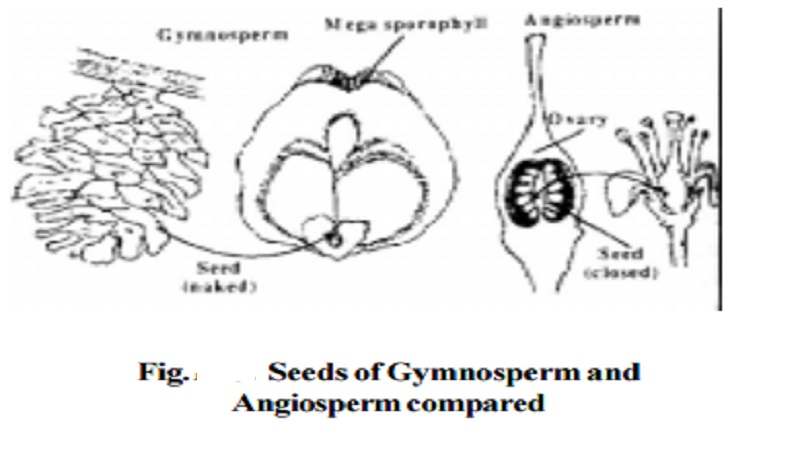Chapter: 11th 12th standard bio zoology Human Body higher secondary school
Classification and Characteristic of Spermatophytes(Gymnosperms)

Spermatophytes (Gymnosperms)
The most successful and advanced group of land plants are the spermatophytes (sperma - seed ). One of the main problems that had to be faced by plants living on land was the vulnarability of their gametophyte generation. For example in ferns the gametophyte is a delicate prothallus and it produces the male gametes (sperms) which are dependent on water for swimming to reach the female gamete in archegonia. In seed plants, however, the gametophyte generation is protected and very much reduced. Three important developments have been made by seed plants.
1. The development of heterospory.
2. The development of seeds.
3. The development of non-swimming male gametes.
Classification and Characteristic of Spermatophytes
Division : Spermatophyta (seed bearing plants)
General Characteristics
Heterosporous - microscope = pollen grain, megaspore = embryo sac. The embryo sac remains completely enclosed in the ovule ; a fertilized ovule is a seed. Sporophyte is the dominant generation, gametophyte is very much reduced. Water is not needed for sexual reproduction because male gametes do not swim, complex vascular tissues in roots, stem and leaves are present. It includes two classes namely Gymnospermae and angiospermae.
GYMNOSPERMS
Salient features of Gymnosperms
Gymnosperms represent a primitive group of seed bearing plant (Spermotophytes) in which the seeds are naked i.e. they are not covered by the fruit wall as in Angiosperms (the word Gymnos means naked and spermos means seed). This is because in Gymnosperms the ovules are exposed and they are not covered by ovary. Instead the ovules are borne directly on open carpellary leaves
called megasporophylls and hence they are naked and they develop into naked seeds after fertilization.
Gymnosperms were most abundant during the
Mesozoic era (225 million years) ago. However, they form only a small part of the present day vegetation. There are about 70 genera and 900 species of gymnosperms distributed in tropical and temperate regions. Most of them are Conifers mostly evergreen, with needle like leaves. They are found in the form of coniferous forests in the Himalayas in the Indian sub-continent. The common conifers are species of pine, fir, spruce,Cedar,Cupressus, Sequoia gigantia, (red wood tree which measures more than 100 meters in height).
Distinguishing features of Gymnosperms
Gymnosperms are woody perennial which are mainly trees and rarely shrubs.
The life cycle of gymnosperms shows heteromorphic alternation of generations.
They form an intermediate group between pteridophytes and Angiosperms i.e they are more advanced than pteridophytes but are primitive than angiosperms.
The plant body is the sporophyte (diploid) mostly a tree with well developed roots, stem and leaves.
The sporophyte bears two types of fertile leaves, the microsporophyll that produces microspores and megasporophyll that produces megaspores.
Mostly the spores are grouped into compact cones or strobili.
Spores on germination develop into gametophytes which are very much reduced, microscopic and dependent on sporophyte.
Ovules are naked.
Pollination is mostly by wind (anemophilous).
Fertilization involves only one fusion. Female gametophyte provides nutrition to the developing embryo. The endosperm (female gametophyte) is a pre-fertilization tissue and is haploid.sac) and the embryo (of the next sporophyte generation). All the nutrients for life are supplied
Seeds are naked and not embedded in fruit.
Vessels are absent in xylem (except Gnetales)
Classification of Gymnosperms
Chamberlain has classified gymnosperms into two classes 1. class Cycadophyta 2. Class Coniferophyta .The class Cycadophyta consists of plants with simple stem, thick cortex but thin wood and simple sporophylls. The class Coniferophyta consists of plants with profusely branched stem, thin cortex, thick wood and complex sporophylls.
Economic importance of Gymnosperms
Woods of many conifers are used in the manufacture of paper. eg. Pinus. Conifers are the source of soft wood for construction, packing and ply wood industry eg. Cedrus, Agathis
Turpentine is obtained from the resin of Pinus. It is used as solvent in paint and polishes. It is also used medicinally for pain, bronchitis etc.
Seeds of Pinus gerardiana are edible.
Ephedrine is an alkaloid obtained from Ephedra. It is used in curing asthma and respiratory problems.
Saw dust of conifers is used in making linoleum and plastics.
Pinus species yield a resin called rosin which is used in water proofing and sealing joints.
Araucaria is an ornamental plant.
Related Topics